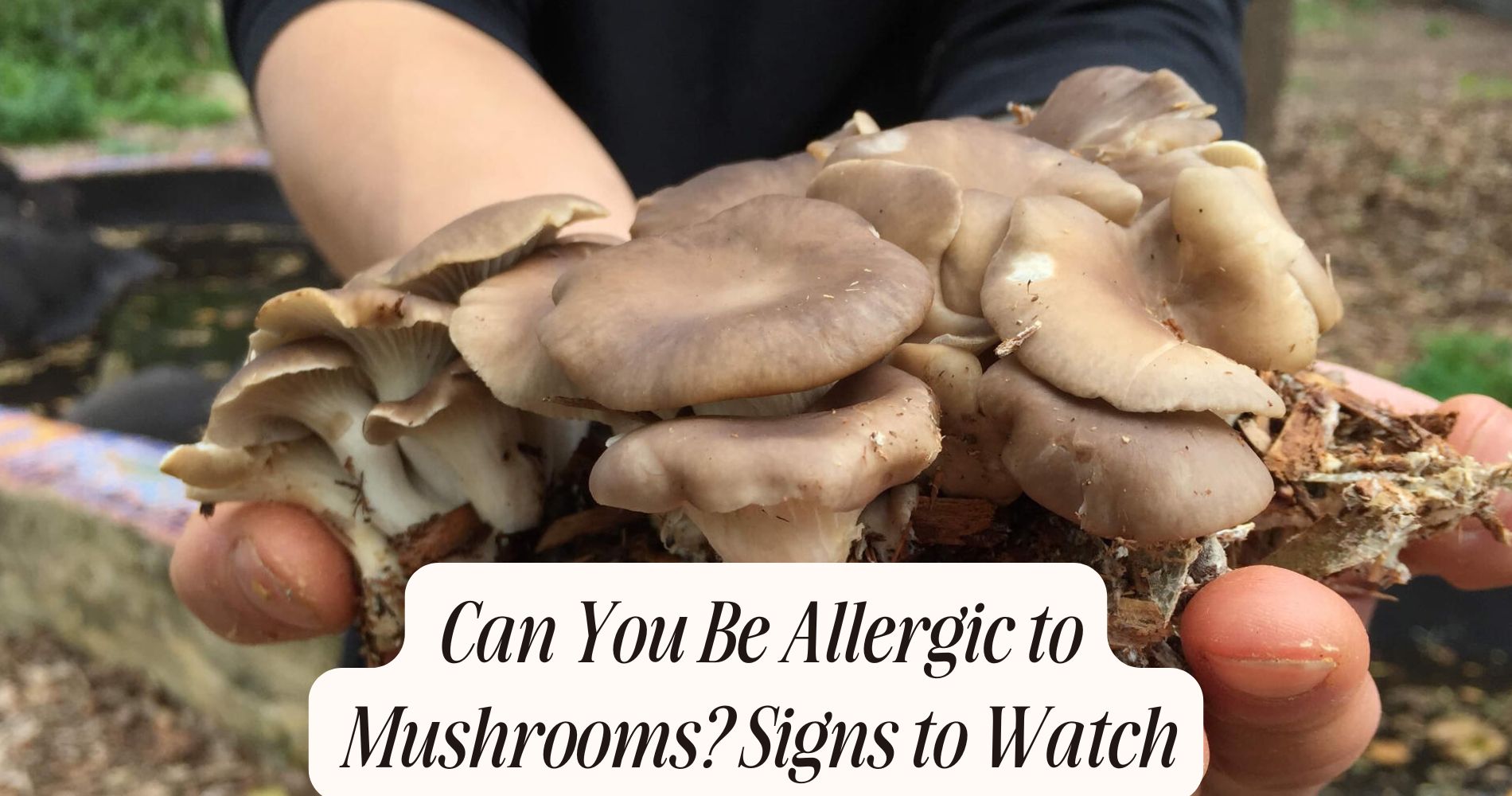
Can You Be Allergic to Mushrooms? Signs to Watch
Can you be allergic to mushrooms? Yes, you can be allergic to mushrooms. If you're allergic, you'll typically notice rapid-onset symptoms like hives, swelling, skin rashes, itching, trouble breathing, nasal congestion, or digestive distress after eating or handling mushrooms. These symptoms are immune-mediated, unlike an intolerance. Diagnosis involves a detailed medical history, skin prick tests, and IgE blood tests. It's important to recognize specific signs early, as severe reactions can occur. You'll find guidance on foods to avoid and management strategies just ahead.
Understanding Mushroom Allergies
Although mushrooms are widely consumed and generally well-tolerated, mushroom allergies can present with a range of immunological reactions. You should recognize that these hypersensitivity responses may arise from exposure to mushroom spores, proteins, or other allergens encountered during mushroom cultivation or culinary uses.
Diagnostic evaluation relies on a detailed clinical history including dietary intake, occupational exposure, and potential cross-reactivity with other fungi. Immunoglobulin E (IgE)-mediated mechanisms are most commonly implicated, but non-IgE pathways can also contribute.

Laboratory assessments, such as skin prick testing or serum-specific IgE assays, support clinical suspicion but must be interpreted in context. Understanding the taxonomy of edible mushrooms is essential, since allergenic proteins vary among species and cultivation methods, influencing sensitization risk.
Accurate diagnosis informs management and dietary recommendations.
Common Symptoms of a Mushroom Allergy
When you develop a mushroom allergy, symptoms can manifest rapidly and range from mild to severe, depending on the immunological pathway involved. You might experience cutaneous reactions such as urticaria, angioedema, or pruritus shortly after ingestion or inhalation of mushroom proteins.
Respiratory symptoms, including rhinitis, bronchospasm, or even anaphylaxis, can occur, particularly if you’re exposed to spores during cooking mushroom varieties.
Gastrointestinal manifestations—nausea, vomiting, abdominal pain, or diarrhea—are also possible.
It’s vital to differentiate these symptoms from food intolerances, as true allergies involve immunoglobulin E (IgE)-mediated hypersensitivity.
While mushroom nutritional benefits are well-documented, individuals with allergies must avoid all forms, regardless of species or preparation.
If you notice these symptoms after exposure, prompt evaluation by an allergy specialist is essential for diagnostic clarification.
How Mushroom Allergies Develop
Recognizing the range of symptoms is only part of understanding mushroom allergies; it's equally important to pinpoint how these reactions originate at the immunological level.
When you're exposed to proteins during mushroom cultivation, your immune system may mistakenly identify certain fungal proteins as threats. This triggers the production of specific IgE antibodies, which sensitize mast cells and basophils.
Upon subsequent exposure, these immune cells release histamine and other mediators, initiating allergic symptoms.

Remarkably, repeated or occupational exposure increases sensitization risk, especially during spore release or handling fresh fungi.
For allergy prevention, you should minimize direct contact with spores and airborne particles in mushroom cultivation environments.
Diagnostic confirmation often involves serum IgE testing or skin prick testing to identify the causative mushroom allergen and guide management strategies.
Foods and Products That May Contain Mushrooms
Surprisingly, mushrooms appear in a broader range of foods and commercial products than many expect, complicating allergen avoidance. Processed foods—such as soups, sauces, gravies, and ready-made meals—often utilize mushrooms as flavor enhancers, ingredients, or thickeners.
Mushroom extracts, powders, and concentrates, byproducts of mushroom cultivation, are frequently added for mushroom nutrition and umami properties. You’ll also find mushrooms in plant-based meat substitutes, nutritional supplements, and certain herbal teas.
Food labels may not specify the species, making diagnostic identification challenging. Additionally, cosmetic products, such as creams and serums, can contain mushroom-derived ingredients, posing an exposure risk for sensitized individuals.
If you suspect a mushroom allergy, it’s crucial to conduct thorough label reviews and communicate with manufacturers about hidden sources to ensure exhaustive allergen management.
Differences Between Mushroom Allergies and Intolerances
Given the hidden presence of mushrooms in numerous products, distinguishing between true mushroom allergies and mushroom intolerances becomes clinically significant for accurate diagnosis and management.
If you have a mushroom allergy, your immune system reacts to specific mushroom proteins, often leading to immediate hypersensitivity responses such as urticaria, angioedema, or even anaphylaxis.

In contrast, mushroom intolerance doesn’t involve the immune system; instead, it typically results from difficulty digesting certain mushroom components or exposure to byproducts of mushroom cultivation, such as residual fungal toxins.
Fungal toxin effects may provoke gastrointestinal discomfort, headaches, or fatigue rather than classic allergic reactions.
Understanding whether your symptoms stem from immune-mediated allergy or non-immune intolerance directly impacts management strategies, including avoidance protocols and appropriate medical interventions tailored to your specific diagnosis.
Diagnosing a Mushroom Allergy
Although mushroom allergies can manifest with diverse symptoms, an accurate diagnosis hinges on a thorough clinical evaluation supported by targeted testing. Your healthcare provider will start by reviewing your medical history, paying close attention to recent exposures to both mushroom cultivation environments and various culinary mushroom varieties.
Skin prick testing and serum-specific IgE testing can help identify sensitization to mushroom proteins. It's essential to differentiate between true allergic reactions and irritant responses, as symptoms may overlap with other food sensitivities.
In certain cases, a supervised oral food challenge may be necessary to confirm a diagnosis. Documenting the exact mushroom species involved—whether commonly cultivated or wild—improves diagnostic accuracy.
Always consult an allergist experienced in food allergies for a comprehensive assessment and personalized guidance.
Managing and Treating Mushroom Allergies
When managing a mushroom allergy, strict avoidance of all forms of the implicated mushroom species remains the cornerstone of treatment. You'll need to scrutinize ingredient labels and inquire about food preparation methods, as cross-contact can occur during mushroom cultivation, processing, or storage. Even trace amounts may provoke an immunologic response.

Consider culinary substitutions such as zucchini, eggplant, or tofu to replicate the texture and umami of mushrooms in recipes without risk. If you dine out, communicate your allergy to kitchen staff to minimize inadvertent exposure.
Carrying an antihistamine is sometimes advised for mild symptoms, but consult your allergist for tailored recommendations.
Regular follow-up with your healthcare provider ensures your management plan remains evidence-based and reflects any changes in diagnostic testing or emerging therapies.
When to Seek Medical Help
If you develop acute symptoms such as difficulty breathing, swelling of the lips or throat, persistent vomiting, or a rapid drop in blood pressure after mushroom exposure, you should seek immediate medical attention, as these may indicate anaphylaxis—a life-threatening allergic reaction.
Clinically, prompt intervention with epinephrine and advanced airway management may be required.
Even mild symptoms—like rash, hives, or gastrointestinal distress—should prompt consultation with an allergist for diagnostic evaluation, including serum-specific IgE testing or oral food challenges.
You can't rely solely on cooking safety, as heating may not denature all allergenic proteins.
Meticulous label reading is essential to avoid inadvertent exposure, especially with processed foods.
If accidental ingestion occurs and symptoms escalate, don’t delay; emergency care is warranted to prevent severe outcomes.
A Convenient Way to Enjoy Mushroom Benefits: SUPER MUSHROOM GUMMIES
If you're curious about the benefits of mushrooms but concerned about potential allergies, consider Well Gummies' SUPER MUSHROOM GUMMIES. These chewable gummies offer a safe and convenient way to enjoy the power of 10 functional mushrooms without the risk of consuming whole fungi. Fuel your brain and energize your body naturally, while supporting immunity and mental clarity. With a delicious fresh wild berry flavor and no jitters or crash, these vegan gummies make it easy to stay balanced and focused throughout the day. Shine bright with Well Gummies!
Frequently Asked Questions
Can Mushroom Allergies Be Outgrown Over Time?
You might not typically outgrow mushroom allergies, as immune sensitization tends to persist. However, controlled exposure in mushroom cultivation settings and strict allergy prevention protocols can sometimes reduce reactivity, but this requires diagnostic evaluation and specialist supervision.
Are Certain Mushroom Species More Allergenic Than Others?
You’ll find certain wild mushroom species trigger allergic reactions more frequently than cultivated varieties due to unique protein profiles. Diagnostic testing can help identify specific allergens, guiding you in avoiding particular species and managing symptoms effectively.
Do Cooked Mushrooms Cause Fewer Allergic Reactions Than Raw Ones?
You may experience fewer culinary allergies from cooked mushrooms because heat denatures allergenic proteins. However, cooking doesn't prevent mushroom poisoning, as some toxins remain heat-stable. Diagnostic assessment should differentiate between allergic reactions and toxic mushroom poisoning for accurate management.
Can Pets Develop Allergies to Mushrooms?
You should know pets can develop hypersensitivity reactions to mushrooms, impacting pet health. Clinical signs may mimic mushroom toxicity, so monitor for vomiting, diarrhea, or skin irritation. Veterinary diagnostic testing distinguishes between allergic responses and toxic ingestion.
Are Mushroom Allergy Tests Covered by Insurance?
When you seek mushroom allergy testing, insurance coverage varies by provider and policy. You’ll need diagnostic justification, such as documented symptoms or physician referral. Confirm with your insurer whether they’ll reimburse mushroom-specific IgE or skin prick testing.
Conclusion
If you suspect a mushroom allergy, pay close attention to clinical symptoms such as urticaria, angioedema, or anaphylaxis following ingestion or exposure. Diagnosis relies on a detailed patient history, specific IgE testing, and, if indicated, oral food challenges under medical supervision. Avoidance remains the primary management strategy, but always carry emergency medication if prescribed. Prompt recognition and intervention are vital, as mushroom allergies can be severe. Consult an allergist for definitive diagnosis and personalized management recommendations.




